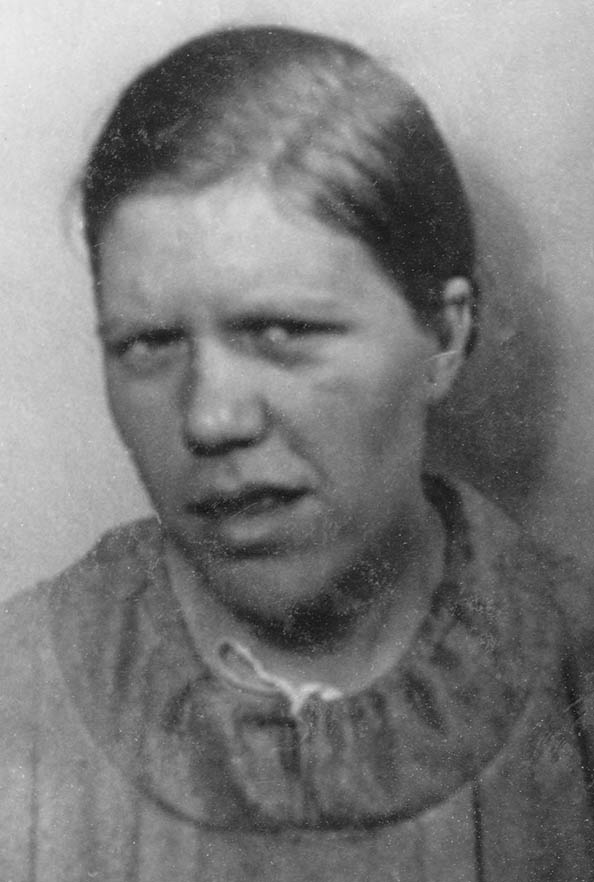Search for Names, Places and Biographies
Already layed Stumbling Stones
Suche
Frieda Brütt * 1909
Steinbeker Hauptstraße 19 (Hamburg-Mitte, Billstedt)
HIER WOHNTE
FRIEDA BRÜTT
JG. 1909
EINGEWIESEN 14.8.1943
’HEILANSTALT’
AM STEINHOF / WIEN
ERMORDET 6.3.1944
Frieda Brütt, born 25 Sep. 1909 in Steinbek, died 6 Mar. 1944 in the Wagner von Jauregg Mental Institute, Vienna (Wagner von Jauregg-Heil- und Pflegeanstalt der Stadt Wien)
Steinbeker Hauptstraße 19 (Steinbeker Straße 20)
Until she was six years old, Frieda Brütt seemed no different from other children. She was born on 25 September 1909 in Steinbek, which, together with Schiffbek and Öjendorf, later became a part of Billstedt, and was incorporated into Hamburg in 1937. She was the second of three children. Her older brother left the family at a young age, and the younger brother died of blood poisoning at the age of three.
When Frieda began school in Steinbek it became clear that she had trouble keeping up with her classmates. She was musically talented, but was not able to learn to read, write, or do arithmetic, and had difficulties with manual skills. Her schooling ended at age 10 or 11, but she had her confirmation ceremony a few years later with children of her own age. On 3 December 1928 she had a daughter, who was raised by the father’s parents. The child was developmentally handicapped from birth.
Frieda Brütt was admitted to the Alsterdorf Asylum on 5 July 1929 as a ward of the Wandsbek welfare agency. She was described as a friendly, calm and neat patient, who did light housework under supervision. She settled in well in the first six months of her stay. Difficulties began when Frieda got into an argument with another patient and hit her. Her father submitted a request for a furlough for Frieda, with the intention of taking her home to live with him, but the Wandsbek welfare agency refused to grant it. Frieda purposefully behaved badly in order to get out of the asylum, but the staff refused to furlough or release her. She finally gave in, got along better with the nursing staff and other patients, became more independent and helped in the kitchen. After she turned 21, she was likely officially declared incompetent.
That Frieda Brütt expressed sexual interests was registered negatively, as was her occasional agitation. She was sedated with a small dose of Luminal (a phenobarbital), but it only proved effective for a short time. The reasons for her episodes of agitation were not noted. Until a new episode in October, Frieda’s behavior in her ward was quiet, friendly, and cooperative. She was working in the kitchen when, for unknown reasons, she became agitated and abusive. She broke a window pane and raised allegations against another patient.
Frieda Brütt came down with scarlet fever. Since the Health Department had issued a directive that all cases of scarlet fever were to be treated in the public hospitals, the young woman was transferred to the Barmbek General Hospital. When she returned to the asylum six weeks later, she resumed her tasks, performing them to the satisfaction of the staff, and seemed to be in good spirits. On 31 October 1936, a recommendation for her sterilization was submitted, and a compulsory sterilization was performed in April 1937 at the Eppendorf University Clinic. After her return to Alsterdorf and a period of recovery, she began showing mood swings that had not been present before: she alternated between non-stop talking and long periods of silence and inactivity. Her condition stabilized in 1938 and she was again cooperative with her tasks, but she didn’t know what to do in her spare time. There were no significant changes in her behavior until 1943, but a grave loss of weight was noted in her files: from 67 kg (148 lbs.) in 1939 to 37.7 kg (83 lbs.) in 1943. The causes of this weight loss were not investigated, nor was the cause of her mood swings, for which she was put under observance in April 1943, and three weeks later into isolation.
After Operation Gomorrah, the devastating Allied air raid campaign on Hamburg in July/August 1943, Pastor Friedrich Lensch, head of the Alsterdorf Asylum, planned to transfer 750 patients to other institutions. Frieda Brütt, who had been diagnosed with "imbecility since birth,” was transferred to the Wagner von Jauregg Mental Institution in Vienna, along with 228 other women and girls. The transport arrived in Vienna on 16 August 1943. When Frieda told the doctor who admitted her that her papers were in order and that she could leave whenever she wanted, he concluded that she was disoriented. In the following months she had various physical complaints and lost more weight. By early 1944 she was bed-ridden and had become fully disoriented. Her complaints subsided when "a suppurated gland burst,” as is noted in her records. On 5 March 1944 she fell and was transferred to a different ward. She died there on the following day, fully exhausted, of "glandular tuberculosis.” Meningitis is also listed as a possible secondary cause of death. In fact she died of malnutrition, insufficient medical care and possibly an overdose of a lethal medication.
Her father Heinrich Brütt received notification of his daughter’s death and burial in the Central Cemetery in Vienna in a letter dated 9 October 1944. Frieda Brütt was 34 years old when she died.
Translator: Amy Lee
Kindly supported by the Hermann Reemtsma Stiftung, Hamburg.
© Initiative Stolpersteine in Hamburg-Billstedt
Quellen: Ev. Stiftung Alsterdorf, Archiv, V 373; Jenner, Meldebögen, in: Wunder/Genkel/Jenner (Hrsg.), Ebene; Wunder, Abtransporte, in: Wunder/Genkel/Jenner (Hrsg.), Ebene; ders., Exodus, ebd.
Zur Nummerierung häufig genutzter Quellen siehe Recherche und Quellen.


